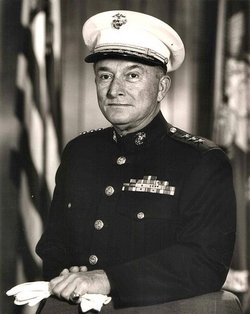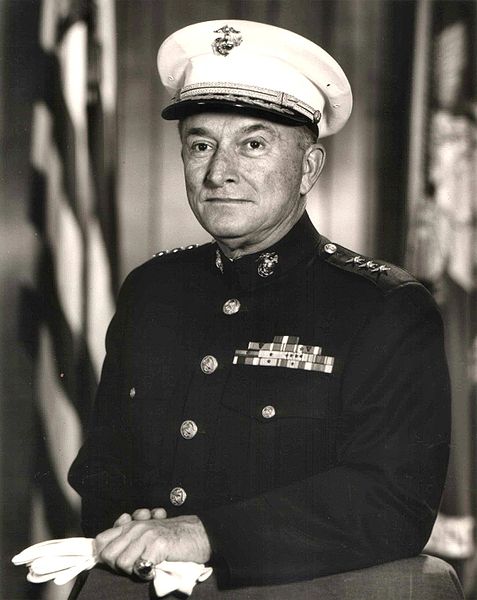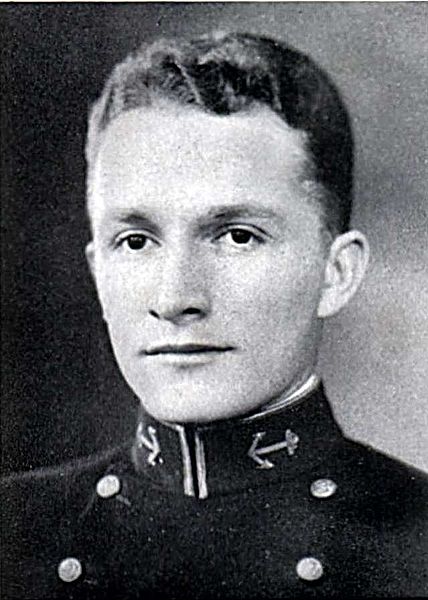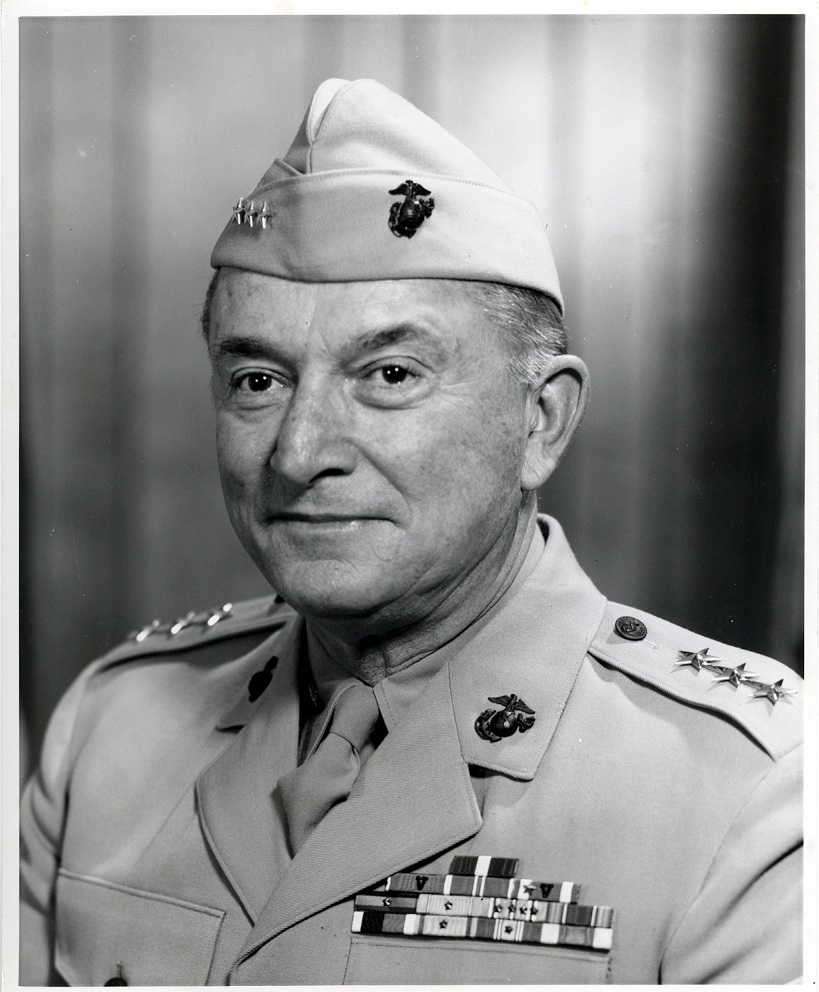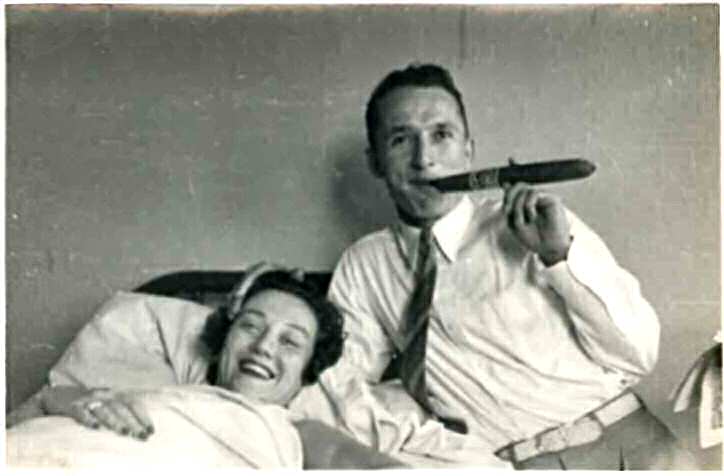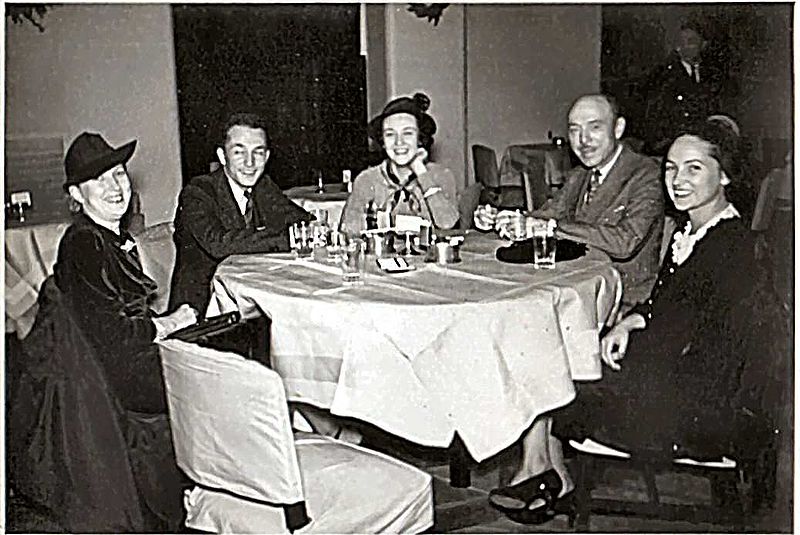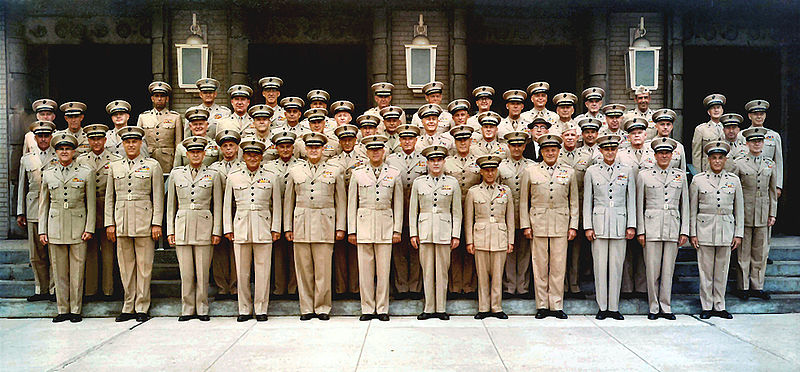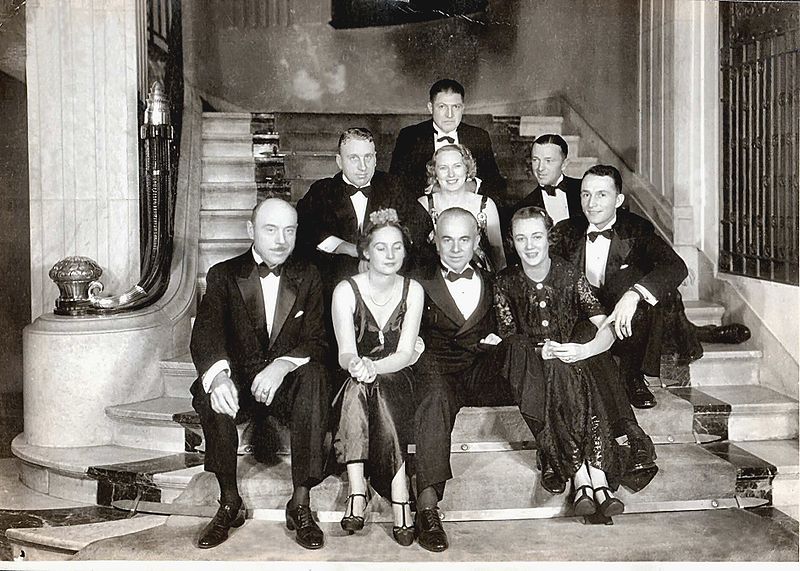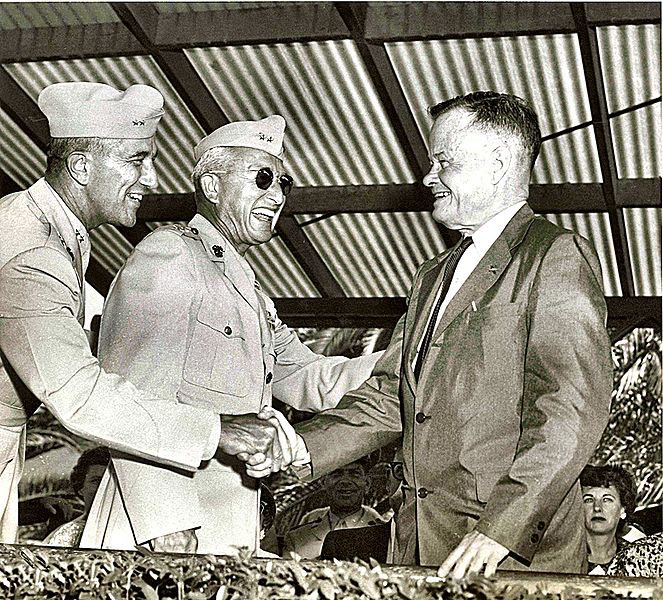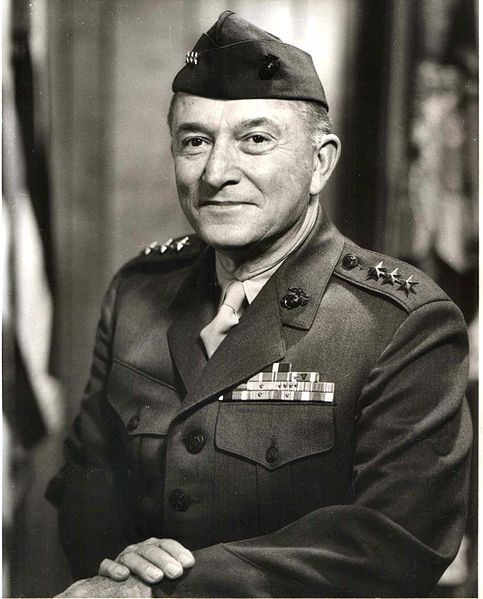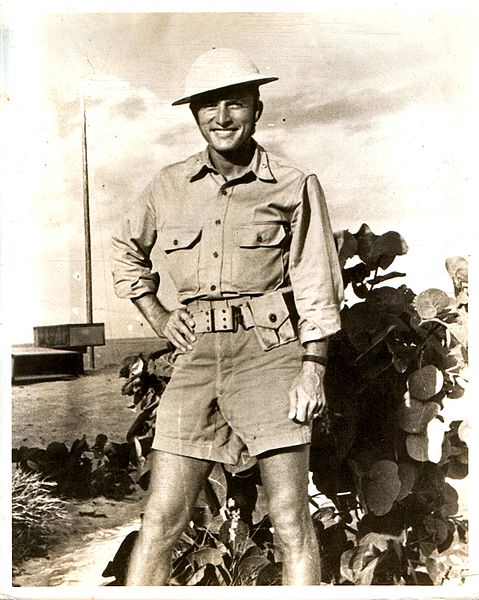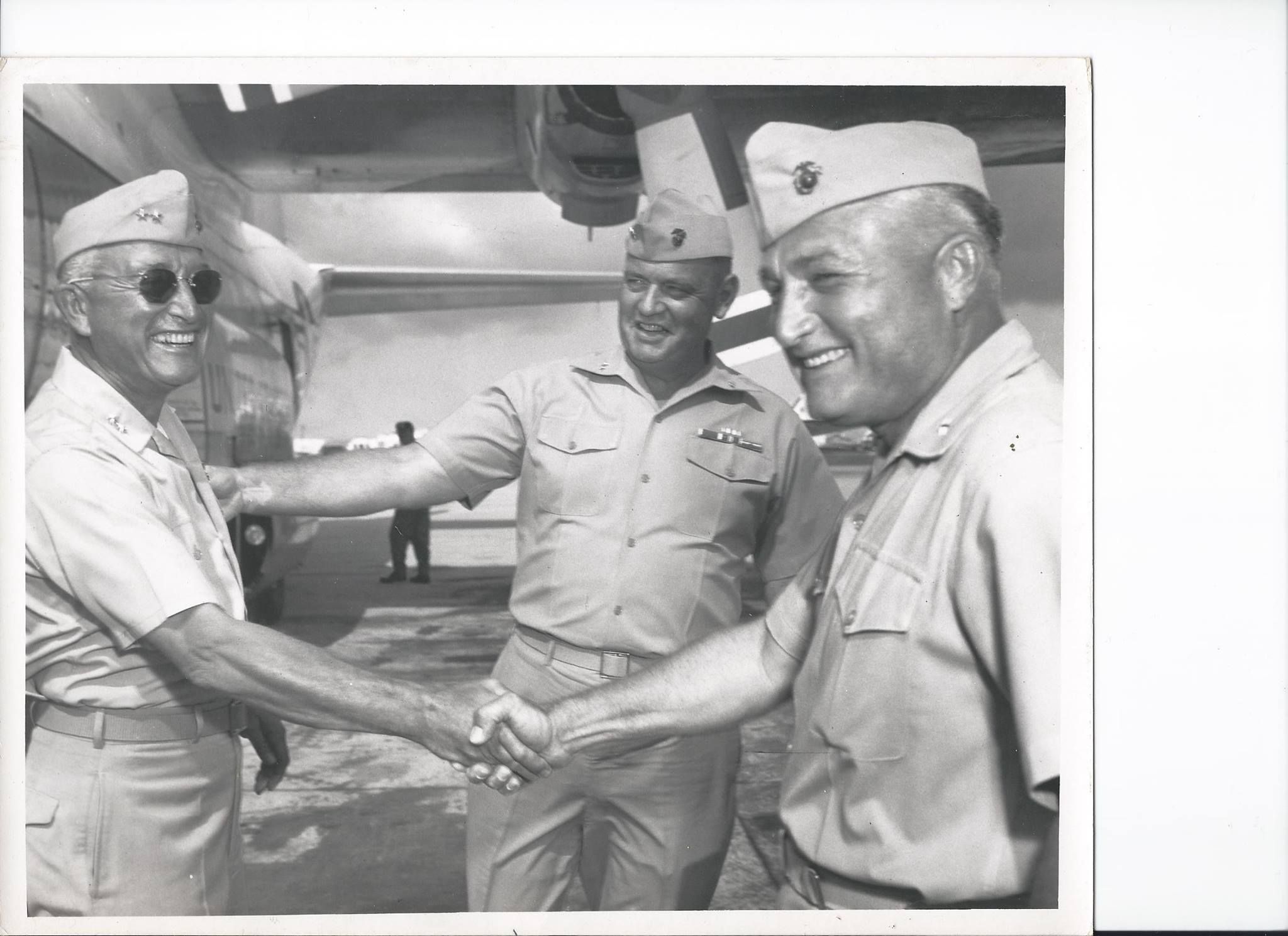James Marvin Masters ('Senior' was added after his namesake father died in 1936) was born on 16 June 1911 in Atlanta, GA, the son of James Marvin and Mary Catherine Kay Masters. After the age of 12, they lived on the family farm in Anderson, SC. James completed high school at Anderson in 1927 at only 16 years of age. In his valedictory speech, he said, "If we fail to prepare for our role in society, we play falsely with our God, our country, and with the inner man, our conscience."
James had appointments to both the U.S. Military Academy and the U.S. Naval Academy when he graduated. However, his father thought he was too young to enter and insisted that James first attend The Citadel for a year. One of James' cousins had graduated from the USNA and encouraged him to go to Annapolis, which he did in 1929.
During his battleship cruise in 1932 as a midshipman, Masters opted for the Marine Corps, observing "...that really made up my mind, because I'd read so much about Marine camaraderie. And I'd also observed it within Marine detachments on board ship, the close relationship between officers and men."
Masters was commissioned as a second lieutenant on June 1, 1933, and reported to The Basic School at the Philadelphia Naval Shipyard. One of Masters' instructors, Anthony Joseph Drexel Biddle, Sr. (nicknamed "Bayonet Tony") took the young Marine under his wing and trained him in close combat. He graduated in May 1934 in the smallest-ever class: 20 academy graduates and one mustang (directly from enlisted to officer). His first assignment was to the Marine Detachment aboard the battleship USS New Mexico, where he was soon qualified as a watch officer. In July 1935, he joined the 1st Marine Brigade at Marine Corps Base Quantico.
Due to the expiration of the then-mandatory marriage waiting-period (two years after graduation), on 14 September 1935, Masters married his sweetheart, Dorice "Dottie" Mary Kengla, the sister of his Naval Academy classmate (and newly-commissioned Marine second lieutenant) William A. Kengla.
After the Fleet Landing Exercises, which saw the USS Arkansas landing 1st Battalion 5th Marines at Culebra, Puerto Rico from January to May 1936, Masters became Personnel, Intelligence, and Communications Officer for the 1st Battalion, 1st Marine Brigade. In July, he was promoted to first lieutenant and, in August, he assumed duties in the Headquarters Company. In December, he became an aide-de-camp to the brigade commander, Brigadier General James J. Meade. The brigade was soon transferred to the West Coast of the U.S., where Masters was detached from the unit for assignment to the Fourth Marine Regiment in China.
In February 1937, Masters and Dorice departed Los Angeles for Shanghai, China on the liner SS President Polk, a trip they shared with Lieutenant Colonel William H. Rupertus, and his wife, Alice. Because Dorice and Alice had gone to school together, James earned his senior's trust and was offered a position in the elder's future command: 1st Battalion 4th Marines. Colonel Charles F. B. Price commanded the regiment in China in 1937 and Price's wife, Dolly, was godmother to Dorice. This connection got Masters a prime assignment working for Lt. Col. Francis I. Fenton, the regiment's Deputy Athletic Officer and Club Officer. He became editor for the regiment's newsweekly magazine, the "Walla Walla" which purportedly meant "much talk" in Chinese.
On 7 July 1937, the Marco Polo Bridge Incident signaled the beginning of the Second Sino-Japanese War. In mid-August, the Chinese conducted an ineffectual bombing raid on the Japanese Fleet; a few bombs even strayed into the Shanghai International Settlement, killing civilians. But Masters got his first ‘taste' of combat, and he soon arranged to be given a command: a platoon and later Company F, under 2nd Battalion commander (and Medal of Honor holder) Roswell Winans. Despite being stationed at Suzhou Creek, his platoon never directly engaged Japanese troops, but witnessed the Defense of Sihang Warehouse. After defending Americans from Japanese harassment until September 1938, he was temporarily assigned to the luxury liner SS President Coolidge, in Shanghai port, to supervise the security during loading of gold and silver bullion that belonged to Chase Bank.
On 16 August 1939, Dorice gave birth to a son, James Jr., who earned the nickname "Champ" after a suggestion from a slightly-inebriated fellow Marine, Bruno Hochmuth. [On 14 November 1967, Major General Hochmuth became the first, and only, Marine Division Commander to be killed – in any war.] The following month, Masters was promoted to Captain.
Masters returned to the U.S. in November of '39 and was assigned to Marine Barracks, Washington, DC, again under William Rupertus. In March 1940, he became a company commander in the Marine Guard detachment at President Franklin D. Roosevelt's personal retreat at Warm Springs, GA, under the command of Lt. Col. Charles T. Brooks. Masters grew close to the president during one extended retreat. At one point, the guards performed a silent exhibition drill for the president and patients at the Roosevelt Warm Springs Institute for Rehabilitation.
In June 1940, Masters served briefly again at MCB Quantico during the Officer Candidates School's Platoon Leaders Course. In September, he was assigned to Marine Corps Base, Parris Island in SC, as a battery commanding officer with the 4th Defense Battalion. He and his family were transferred with the battalion to Guantanamo Bay Naval Base, Cuba in February 1941. In November, they embarked on board the USS Henderson with the battalion for Pearl Harbor, HI, the week before the surprise attack. The Masters family arrived at Pearl on 1 December 1941. As the air attack raged on the morning of Sunday, 7 December, James was slowed by gawking sightseers on the road to Pearl, and couldn't make it to his post until the attack was over. War was declared the next day and Masters embarked aboard the USS Mahan enroute to, and in command of, the first reinforcements for Johnston Island on Christmas Day. Masters did not see his family again for over two years.
Masters remained at Johnston Island until November 1942, receiving a Bronze Star for his service there. In May, he was promoted to Major and, shortly after, Admiral Chester W. Nimitz paid a visit to Johnston, boosting morale. The same month, Masters returned to Pearl Harbor to join the 10th Defense Battalion. Later, as executive officer of the battalion and attached to the I Marine Amphibious Corps, he served in the Solomon and Russell Islands.
He was promoted to Lieutenant Colonel in April 1943. In August, he commanded 2nd Battalion 1st Marines briefly in Australia prior to bringing the unit into combat again at the Battle of Cape Gloucester. There, he was once again under the command of Rupertus, who was now the Commanding General of the 1st Marine Division. The battle was part of the larger New Britain campaign, named Operation Dexterity which, in turn, was part of Operation Cartwheel of the Solomon Islands and New Guinea campaigns. While at Finschhafen preparing for the Cape Gloucester landings, General Douglas MacArthur inquired of Masters, "Young man, are you ready for this operation?" He replied, "More important, General, my troops are ready," which drew a grin from MacArthur.
On the morning of 26 December 1943, the first wave of Landing Craft Mechanized landed on Green beach. The landing was unopposed, and even after the Marines were ashore, no enemy resistance was encountered. By nightfall Masters' troops ‘Stoneface Group' had met all of its defensive position objectives and began patrolling inland to locate enemy troops. The first two days brought just a few skirmishes. As daylight faded on 29 December, the volume of Japanese fire from the jungle began to increase, signaling an imminent attack against Stoneface defenses.
At about 2 AM, the Japanese made a Banzai charge that killed 6 Marines at the point of attack. For a few moments, enemy troops occupied part of Stoneface Group's front lines, but were repulsed when Gunnery Sergeant Guiseppe Guilano Jr. stepped into the breach with a light machine gun. A second Japanese assault nearly overran Marine positions, but again it was beaten back, with Guilano (wounded seven times during the night) at the forefront. After the second failed assault, two further dispirited banzai attacks were stopped cold. As dawn broke, a casualty count found 6 Marines killed with 13 wounded, while a burial detachment at the front lines counted 256 enemy killed. Five prisoners were captured, including an English-speaking Japanese officer. When MacArthur learned of the captured officer, he sent a PT boat to deliver the prisoner to Finschhafen for interrogation. Later, MacArthur sent a congratulatory dispatch indicating that the prisoner was the first Japanese officer of the war to be captured alive. Masters recommended Guilano for the Medal of Honor for his heroics, but it was downgraded by General Rupertus to a Navy Cross.
Once the entire airdrome was firmly in Marine hands, General Rupertus raised the American flag there and dispatched the news to General Walter Krueger. General Rupertus ordered Masters to secure his battalion and rejoin the Division, where the Stoneface Group was disbanded on 12 January 1944.
Masters and his battalion were then reassigned to the 7th Marine Regiment. When Masters reported, he was met by executive officer Lt. Col. Lewis "Chesty" Puller [Puller became the most decorated U.S. Marine in history], with whom he had served in China. As the senior officer, Puller took the opportunity to indulge in some combat humor at the expense of Masters by belittling the 2nd Battalion's 'little fight' at the hands of the Banzai charging Japanese troops at Mt. Talawe.
For his actions on Cape Gloucester, Masters was awarded the Legion of Merit [somewhat unusual for a combat commander to receive] instead of the Silver Star. In March 1944, after 37 consecutive months overseas, he returned to the U.S. for duty at Headquarters Marine Corps with the Division of Plans and Policies, G-3. Upon seeing him for the first time in over two years, his son, now-nearly 5 years old, didn't know who he was. In September, Masters detached for duty at Pearl Harbor, and then on Guam, Saipan, and Tinian.
In November ‘44, Masters was transferred to the 7th Marine Regiment and began serving as executive officer at Pavuvu. From April to June 1945, he fought in the Battle of Okinawa, where he earned the Navy Cross for manning a vital observation post under heavy attack during the assault on Dakeshi Ridge.
Masters returned to China in October 1945 as the Assistant Chief of Staff, G-2 for 1st Marine Division at Tientsin. When he returned to the U.S. in March '46, he was again assigned to Headquarters Marine Corps where, in May, he began a two-year assignment in the Inspection Division. In May 1948, he was ordered to the Marine Corps Schools, Quantico, serving as Executive Officer, and later, as Commanding Officer of the Basic School. He was promoted to Colonel in August 1949. In September of ‘50, he was transferred to Camp Lejeune, NC, to assume command of the 8th Marine Regiment, 2nd Marine Division for 18 months. He attended the National War College from August 1952 to June 1953, after which he became a member of the Joint Strategic Plans Group, Joint Chiefs of Staff, for two years.
In August 1955, Masters took command of the 4th Marine Regiment, 3rd Marine Division, at Marine Corps Air Station Kaneohe Bay, HI until he was named Fleet Marine Force, Pacific Liaison Officer to the Commander in Chief, Pacific Fleet, in June 1956. While serving in this capacity, he was promoted to Brigadier General in July 1957. He returned to Headquarters Marine Corps as Assistant Chief of Staff, G-2 in September 1957. He was assigned additional duty as Inspector General of the Marine Corps in June 1960, and was promoted to Major General the following month.
On 31 July 1961, Masters assumed command of 1st Marine Division at Marine Corps Base Camp Pendleton, CA; in June 1962 he became Commanding General of the base. He returned to Okinawa in May 1963 to command 3rd Marine Division. He then commanded Marine Corps Recruit Depot Parris Island from June 1964 to June 1966. Promoted to Lieutenant General on 1 July 1966, he was assigned duty as Commandant, Marine Corps Schools, Quantico. In January 1968, Marine Corps Schools was re-designated Marine Corps Development and Education Command, and Masters' title was changed to Commanding General.
Masters was presented the Navy Distinguished Service Medal by Marine Commandant Leonard F. Chapman, Jr. during his retirement ceremony at Quantico on 28 June 1968.
During his military career, Masters received the following medals and awards: Navy Cross; Distinguished Service Medal; Legion of Merit with Combat "V"; Bronze Star Medal; Navy Commendation Medal with Combat "V" (2 Awards); Presidential Unit Citation; China Service Medal with one Bronze Star; American Defense Service Medal with Base clasp; Asiatic-Pacific Campaign Medal with one Silver Star (indicative of five bronze stars); World War II Victory Medal; National Defense Service Medal with one Bronze Star; Chinese Order of the Cloud and Banner; and the Korean Order of Service Merit Second Class.
Lieutenant General James Marvin Masters, Sr. died at his home in Washington, DC, on 5 August 1988. He was survived by his beloved wife, Dottie, who died on 14 May 1990 and was buried next to him.
Bio compiled by Charles A. Lewis
Honors
LtGen James M. Masters has Honoree Record 3289 at MilitaryHallofHonor.com.
James Marvin Masters ('Senior' was added after his namesake father died in 1936) was born on 16 June 1911 in Atlanta, GA, the son of James Marvin and Mary Catherine Kay Masters. After the age of 12, they lived on the family farm in Anderson, SC. James completed high school at Anderson in 1927 at only 16 years of age. In his valedictory speech, he said, "If we fail to prepare for our role in society, we play falsely with our God, our country, and with the inner man, our conscience."
James had appointments to both the U.S. Military Academy and the U.S. Naval Academy when he graduated. However, his father thought he was too young to enter and insisted that James first attend The Citadel for a year. One of James' cousins had graduated from the USNA and encouraged him to go to Annapolis, which he did in 1929.
During his battleship cruise in 1932 as a midshipman, Masters opted for the Marine Corps, observing "...that really made up my mind, because I'd read so much about Marine camaraderie. And I'd also observed it within Marine detachments on board ship, the close relationship between officers and men."
Masters was commissioned as a second lieutenant on June 1, 1933, and reported to The Basic School at the Philadelphia Naval Shipyard. One of Masters' instructors, Anthony Joseph Drexel Biddle, Sr. (nicknamed "Bayonet Tony") took the young Marine under his wing and trained him in close combat. He graduated in May 1934 in the smallest-ever class: 20 academy graduates and one mustang (directly from enlisted to officer). His first assignment was to the Marine Detachment aboard the battleship USS New Mexico, where he was soon qualified as a watch officer. In July 1935, he joined the 1st Marine Brigade at Marine Corps Base Quantico.
Due to the expiration of the then-mandatory marriage waiting-period (two years after graduation), on 14 September 1935, Masters married his sweetheart, Dorice "Dottie" Mary Kengla, the sister of his Naval Academy classmate (and newly-commissioned Marine second lieutenant) William A. Kengla.
After the Fleet Landing Exercises, which saw the USS Arkansas landing 1st Battalion 5th Marines at Culebra, Puerto Rico from January to May 1936, Masters became Personnel, Intelligence, and Communications Officer for the 1st Battalion, 1st Marine Brigade. In July, he was promoted to first lieutenant and, in August, he assumed duties in the Headquarters Company. In December, he became an aide-de-camp to the brigade commander, Brigadier General James J. Meade. The brigade was soon transferred to the West Coast of the U.S., where Masters was detached from the unit for assignment to the Fourth Marine Regiment in China.
In February 1937, Masters and Dorice departed Los Angeles for Shanghai, China on the liner SS President Polk, a trip they shared with Lieutenant Colonel William H. Rupertus, and his wife, Alice. Because Dorice and Alice had gone to school together, James earned his senior's trust and was offered a position in the elder's future command: 1st Battalion 4th Marines. Colonel Charles F. B. Price commanded the regiment in China in 1937 and Price's wife, Dolly, was godmother to Dorice. This connection got Masters a prime assignment working for Lt. Col. Francis I. Fenton, the regiment's Deputy Athletic Officer and Club Officer. He became editor for the regiment's newsweekly magazine, the "Walla Walla" which purportedly meant "much talk" in Chinese.
On 7 July 1937, the Marco Polo Bridge Incident signaled the beginning of the Second Sino-Japanese War. In mid-August, the Chinese conducted an ineffectual bombing raid on the Japanese Fleet; a few bombs even strayed into the Shanghai International Settlement, killing civilians. But Masters got his first ‘taste' of combat, and he soon arranged to be given a command: a platoon and later Company F, under 2nd Battalion commander (and Medal of Honor holder) Roswell Winans. Despite being stationed at Suzhou Creek, his platoon never directly engaged Japanese troops, but witnessed the Defense of Sihang Warehouse. After defending Americans from Japanese harassment until September 1938, he was temporarily assigned to the luxury liner SS President Coolidge, in Shanghai port, to supervise the security during loading of gold and silver bullion that belonged to Chase Bank.
On 16 August 1939, Dorice gave birth to a son, James Jr., who earned the nickname "Champ" after a suggestion from a slightly-inebriated fellow Marine, Bruno Hochmuth. [On 14 November 1967, Major General Hochmuth became the first, and only, Marine Division Commander to be killed – in any war.] The following month, Masters was promoted to Captain.
Masters returned to the U.S. in November of '39 and was assigned to Marine Barracks, Washington, DC, again under William Rupertus. In March 1940, he became a company commander in the Marine Guard detachment at President Franklin D. Roosevelt's personal retreat at Warm Springs, GA, under the command of Lt. Col. Charles T. Brooks. Masters grew close to the president during one extended retreat. At one point, the guards performed a silent exhibition drill for the president and patients at the Roosevelt Warm Springs Institute for Rehabilitation.
In June 1940, Masters served briefly again at MCB Quantico during the Officer Candidates School's Platoon Leaders Course. In September, he was assigned to Marine Corps Base, Parris Island in SC, as a battery commanding officer with the 4th Defense Battalion. He and his family were transferred with the battalion to Guantanamo Bay Naval Base, Cuba in February 1941. In November, they embarked on board the USS Henderson with the battalion for Pearl Harbor, HI, the week before the surprise attack. The Masters family arrived at Pearl on 1 December 1941. As the air attack raged on the morning of Sunday, 7 December, James was slowed by gawking sightseers on the road to Pearl, and couldn't make it to his post until the attack was over. War was declared the next day and Masters embarked aboard the USS Mahan enroute to, and in command of, the first reinforcements for Johnston Island on Christmas Day. Masters did not see his family again for over two years.
Masters remained at Johnston Island until November 1942, receiving a Bronze Star for his service there. In May, he was promoted to Major and, shortly after, Admiral Chester W. Nimitz paid a visit to Johnston, boosting morale. The same month, Masters returned to Pearl Harbor to join the 10th Defense Battalion. Later, as executive officer of the battalion and attached to the I Marine Amphibious Corps, he served in the Solomon and Russell Islands.
He was promoted to Lieutenant Colonel in April 1943. In August, he commanded 2nd Battalion 1st Marines briefly in Australia prior to bringing the unit into combat again at the Battle of Cape Gloucester. There, he was once again under the command of Rupertus, who was now the Commanding General of the 1st Marine Division. The battle was part of the larger New Britain campaign, named Operation Dexterity which, in turn, was part of Operation Cartwheel of the Solomon Islands and New Guinea campaigns. While at Finschhafen preparing for the Cape Gloucester landings, General Douglas MacArthur inquired of Masters, "Young man, are you ready for this operation?" He replied, "More important, General, my troops are ready," which drew a grin from MacArthur.
On the morning of 26 December 1943, the first wave of Landing Craft Mechanized landed on Green beach. The landing was unopposed, and even after the Marines were ashore, no enemy resistance was encountered. By nightfall Masters' troops ‘Stoneface Group' had met all of its defensive position objectives and began patrolling inland to locate enemy troops. The first two days brought just a few skirmishes. As daylight faded on 29 December, the volume of Japanese fire from the jungle began to increase, signaling an imminent attack against Stoneface defenses.
At about 2 AM, the Japanese made a Banzai charge that killed 6 Marines at the point of attack. For a few moments, enemy troops occupied part of Stoneface Group's front lines, but were repulsed when Gunnery Sergeant Guiseppe Guilano Jr. stepped into the breach with a light machine gun. A second Japanese assault nearly overran Marine positions, but again it was beaten back, with Guilano (wounded seven times during the night) at the forefront. After the second failed assault, two further dispirited banzai attacks were stopped cold. As dawn broke, a casualty count found 6 Marines killed with 13 wounded, while a burial detachment at the front lines counted 256 enemy killed. Five prisoners were captured, including an English-speaking Japanese officer. When MacArthur learned of the captured officer, he sent a PT boat to deliver the prisoner to Finschhafen for interrogation. Later, MacArthur sent a congratulatory dispatch indicating that the prisoner was the first Japanese officer of the war to be captured alive. Masters recommended Guilano for the Medal of Honor for his heroics, but it was downgraded by General Rupertus to a Navy Cross.
Once the entire airdrome was firmly in Marine hands, General Rupertus raised the American flag there and dispatched the news to General Walter Krueger. General Rupertus ordered Masters to secure his battalion and rejoin the Division, where the Stoneface Group was disbanded on 12 January 1944.
Masters and his battalion were then reassigned to the 7th Marine Regiment. When Masters reported, he was met by executive officer Lt. Col. Lewis "Chesty" Puller [Puller became the most decorated U.S. Marine in history], with whom he had served in China. As the senior officer, Puller took the opportunity to indulge in some combat humor at the expense of Masters by belittling the 2nd Battalion's 'little fight' at the hands of the Banzai charging Japanese troops at Mt. Talawe.
For his actions on Cape Gloucester, Masters was awarded the Legion of Merit [somewhat unusual for a combat commander to receive] instead of the Silver Star. In March 1944, after 37 consecutive months overseas, he returned to the U.S. for duty at Headquarters Marine Corps with the Division of Plans and Policies, G-3. Upon seeing him for the first time in over two years, his son, now-nearly 5 years old, didn't know who he was. In September, Masters detached for duty at Pearl Harbor, and then on Guam, Saipan, and Tinian.
In November ‘44, Masters was transferred to the 7th Marine Regiment and began serving as executive officer at Pavuvu. From April to June 1945, he fought in the Battle of Okinawa, where he earned the Navy Cross for manning a vital observation post under heavy attack during the assault on Dakeshi Ridge.
Masters returned to China in October 1945 as the Assistant Chief of Staff, G-2 for 1st Marine Division at Tientsin. When he returned to the U.S. in March '46, he was again assigned to Headquarters Marine Corps where, in May, he began a two-year assignment in the Inspection Division. In May 1948, he was ordered to the Marine Corps Schools, Quantico, serving as Executive Officer, and later, as Commanding Officer of the Basic School. He was promoted to Colonel in August 1949. In September of ‘50, he was transferred to Camp Lejeune, NC, to assume command of the 8th Marine Regiment, 2nd Marine Division for 18 months. He attended the National War College from August 1952 to June 1953, after which he became a member of the Joint Strategic Plans Group, Joint Chiefs of Staff, for two years.
In August 1955, Masters took command of the 4th Marine Regiment, 3rd Marine Division, at Marine Corps Air Station Kaneohe Bay, HI until he was named Fleet Marine Force, Pacific Liaison Officer to the Commander in Chief, Pacific Fleet, in June 1956. While serving in this capacity, he was promoted to Brigadier General in July 1957. He returned to Headquarters Marine Corps as Assistant Chief of Staff, G-2 in September 1957. He was assigned additional duty as Inspector General of the Marine Corps in June 1960, and was promoted to Major General the following month.
On 31 July 1961, Masters assumed command of 1st Marine Division at Marine Corps Base Camp Pendleton, CA; in June 1962 he became Commanding General of the base. He returned to Okinawa in May 1963 to command 3rd Marine Division. He then commanded Marine Corps Recruit Depot Parris Island from June 1964 to June 1966. Promoted to Lieutenant General on 1 July 1966, he was assigned duty as Commandant, Marine Corps Schools, Quantico. In January 1968, Marine Corps Schools was re-designated Marine Corps Development and Education Command, and Masters' title was changed to Commanding General.
Masters was presented the Navy Distinguished Service Medal by Marine Commandant Leonard F. Chapman, Jr. during his retirement ceremony at Quantico on 28 June 1968.
During his military career, Masters received the following medals and awards: Navy Cross; Distinguished Service Medal; Legion of Merit with Combat "V"; Bronze Star Medal; Navy Commendation Medal with Combat "V" (2 Awards); Presidential Unit Citation; China Service Medal with one Bronze Star; American Defense Service Medal with Base clasp; Asiatic-Pacific Campaign Medal with one Silver Star (indicative of five bronze stars); World War II Victory Medal; National Defense Service Medal with one Bronze Star; Chinese Order of the Cloud and Banner; and the Korean Order of Service Merit Second Class.
Lieutenant General James Marvin Masters, Sr. died at his home in Washington, DC, on 5 August 1988. He was survived by his beloved wife, Dottie, who died on 14 May 1990 and was buried next to him.
Bio compiled by Charles A. Lewis
Honors
LtGen James M. Masters has Honoree Record 3289 at MilitaryHallofHonor.com.
